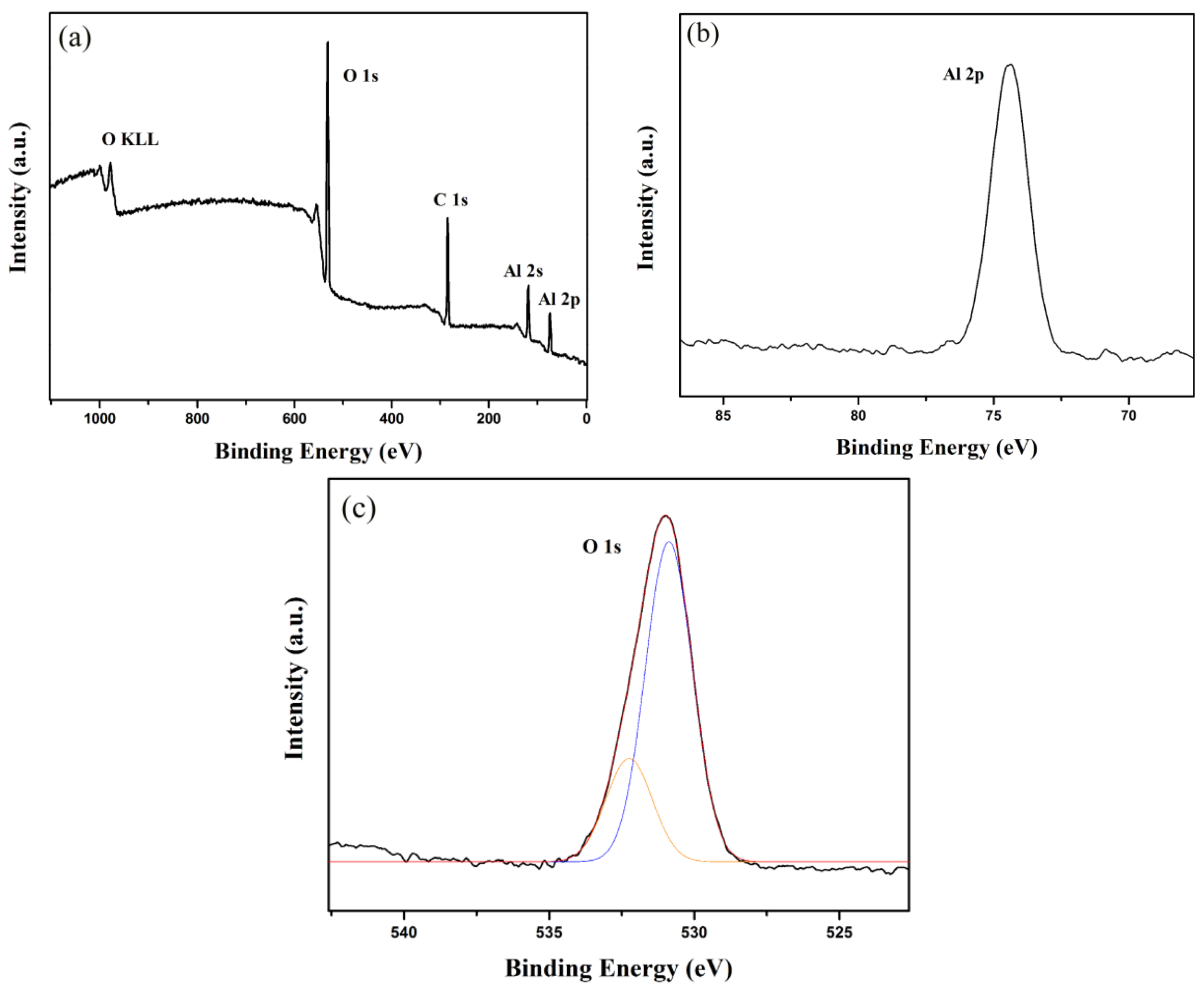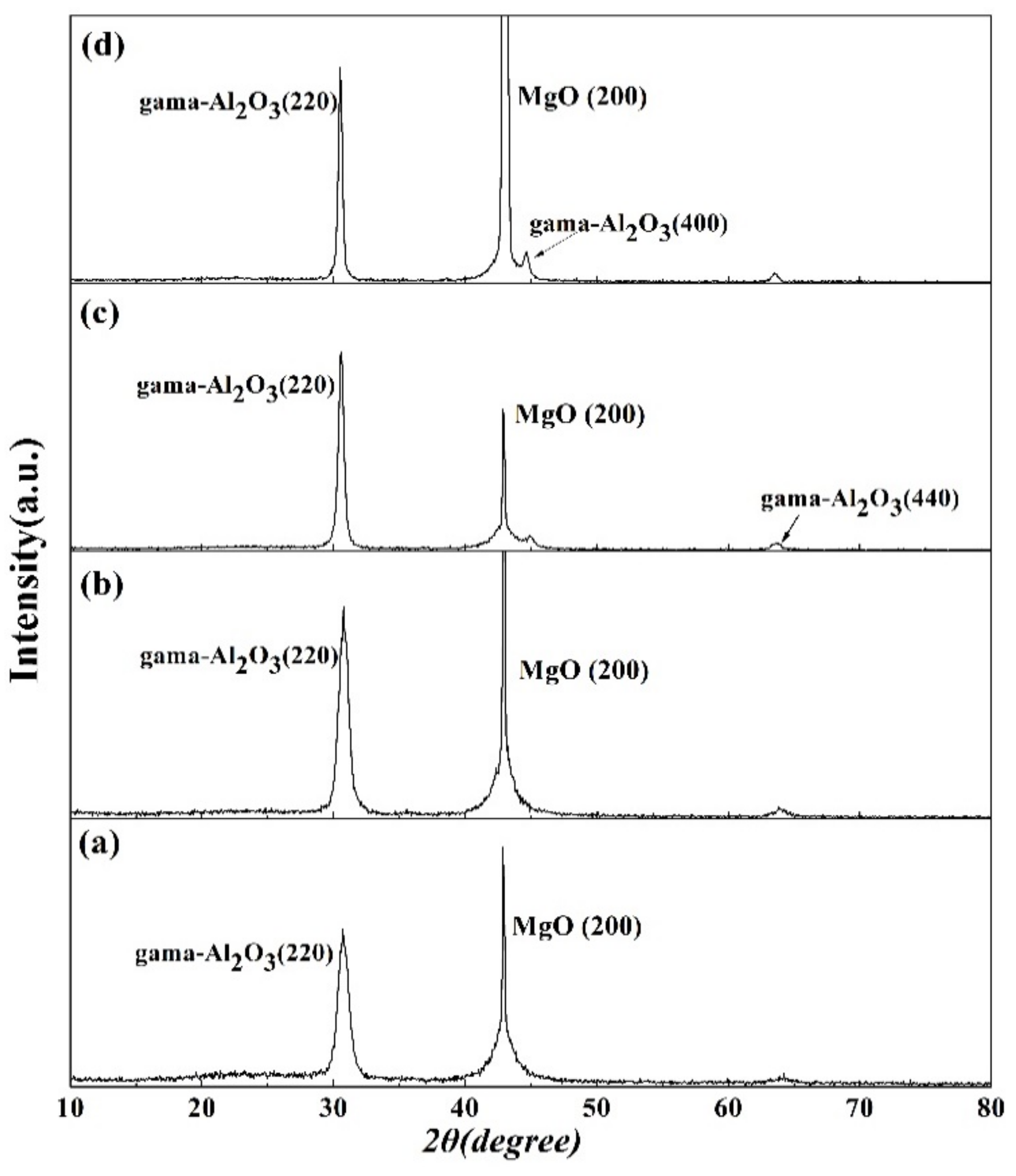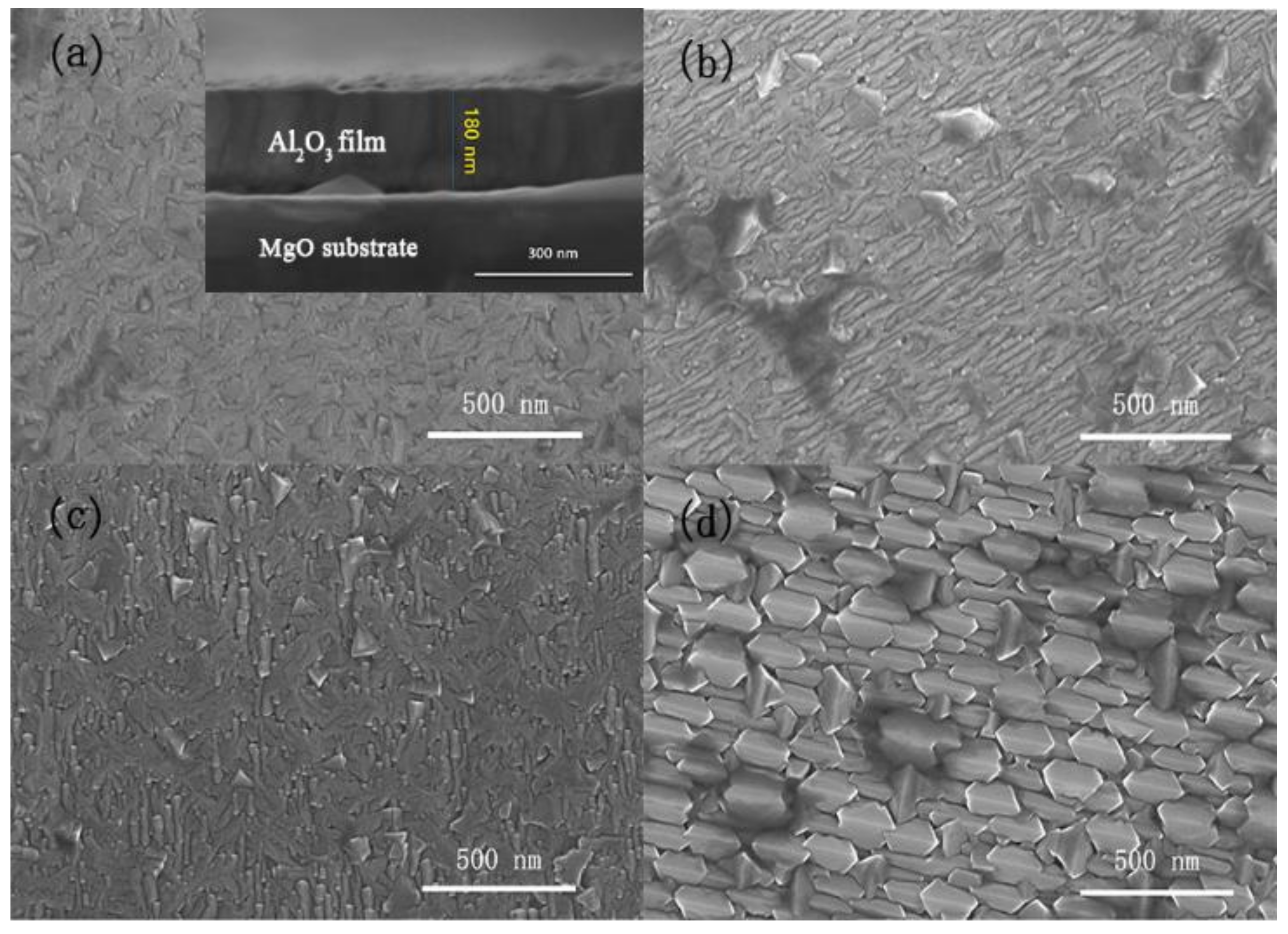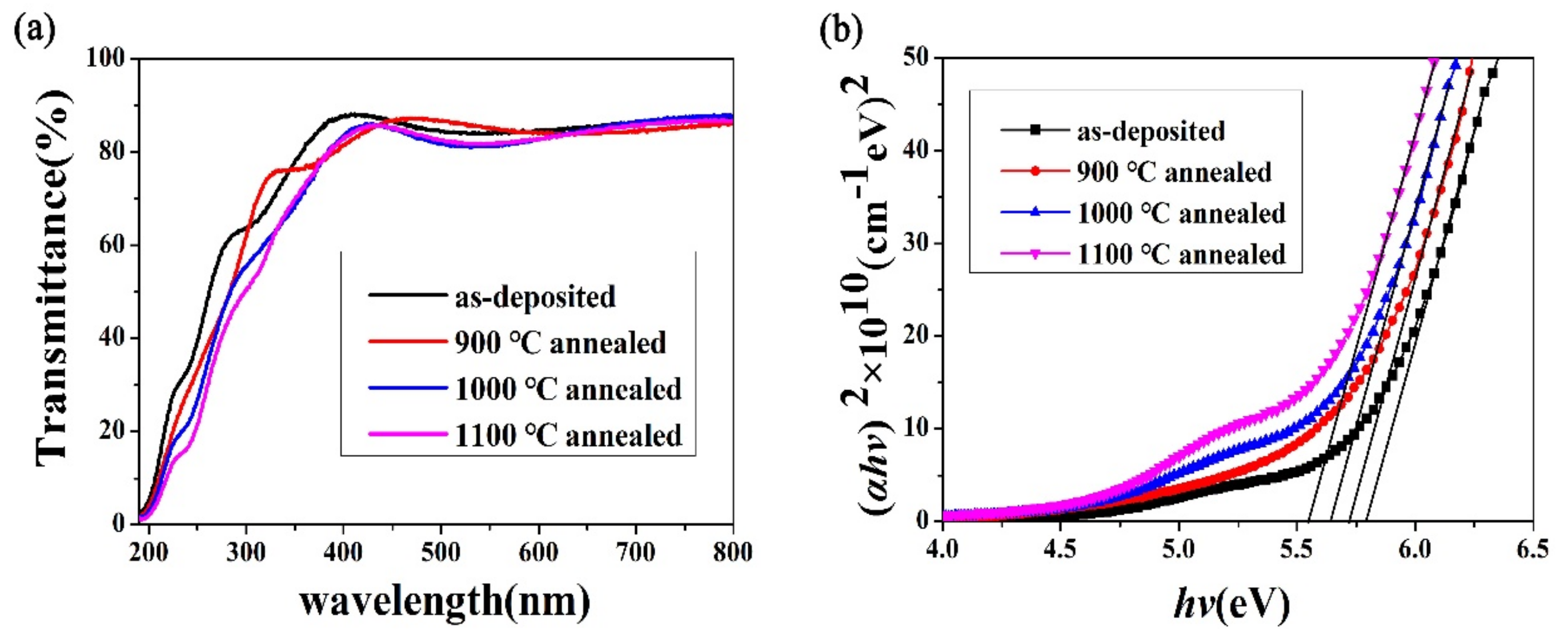Study of the Annealing Effect on the γ-Phase Aluminum Oxide Films Prepared by the High-Vacuum MOCVD System
Abstract
:1. Introduction
2. Experimental Details
3. Results and Discussion
4. Conclusions
Author Contributions
Funding
Conflicts of Interest
References
- Sun, Y.R.; Giebink, N.C.; Kanno, H.; Ma, B.W.; Thompson, M.E.; Forrest, S.R. Management of singlet and triplet excitons for efficient white organic light-emitting devices. Nat. Cell Biol. 2006, 440, 908–912. [Google Scholar] [CrossRef] [Green Version]
- Peng, W.; He, Y.; Wen, C.; Ma, K. Surface acoustic wave ultraviolet detector based on zinc oxide nanowire sensing layer. Sens. Actuators A Phys. 2012, 184, 34–40. [Google Scholar] [CrossRef]
- Jeong, S.; Jeong, Y.; Moon, J. Solution-processed zinc tin oxide semiconductor for thin-film transistors. J. Phys. Chem. C 2008, 112, 11082–11085. [Google Scholar] [CrossRef]
- Hara, K.; Horiguchi, T.; Kinoshita, T.; Sayama, K.; Sugihara, H.; Arakawa, H. Highly efficient photon-to-electron conversion with mercurochrome-sensitized nanoporous oxide semiconductor solar cells. Sol. Energy Mater. Sol. Cells 2000, 64, 115–134. [Google Scholar] [CrossRef]
- Kim, K.; Park, J.H.; Kim, H.; Kim, J.K.; Schubert, E.F.; Cho, J. Energy bandgap variation in oblique angle-deposited indium tin oxide. Appl. Phys. Lett. 2016, 108, 041910. [Google Scholar] [CrossRef]
- Ansari, S.A.; Khan, M.M.; Kalathil, S.; Nisar, A.; Lee, J.; Cho, M.H. Oxygen vacancy induced band gap narrowing of ZnO nanostructures by an electrochemically active biofilm. Nanoscale 2013, 5, 9238–9246. [Google Scholar] [CrossRef] [PubMed]
- Othman, H.; Valiev, D.; Polisadova, E. Structural and mechanical properties of zinc aluminoborate glasses with different content of aluminum oxide. J. Mater. Sci. Mater. Electron. 2017, 28, 4647–4653. [Google Scholar] [CrossRef]
- Lee, B.R.; Lee, T.H.; Son, K.-R.; Kim, T.G. ITO/Ag/AlN/Al2O3 multilayer electrodes with conductive channels: Application in ultraviolet light-emitting diodes. J. Alloys Compd. 2018, 741, 21–27. [Google Scholar] [CrossRef]
- Zhang, G.Z.; Wu, H.; Chen, C.; Wang, T.; Wang, P.Y.; Mai, L.Q.; Yue, J.; Liu, C. Transparent capacitors based on nanolaminate Al2O3/TiO2/Al2O3 with H2O and O3 as oxidizers. Appl. Phys. Lett. 2014, 104, 163503. [Google Scholar] [CrossRef]
- Eng, P.J.; Trainor, T.P.; Brown, G.E., Jr.; Waychunas, G.A.; Newville, M.; Sutton, S.R.; Rivers, M.L. Structure of the hydrated α-Al2O3 (0001) surface. Science 2000, 288, 1029–1033. [Google Scholar] [CrossRef]
- Chou, T.C.; Nieh, T.G. Nucleation and concurrent anomalous grain growth of α-Al2O3 during γ-α phase transformation. J. Am. Ceram. Soc. 1991, 74, 2270–2279. [Google Scholar] [CrossRef]
- Paunović, N.; Dohčević-Mitrović, Z.; Scurtu, R.; Aškrabić, S.; Prekajski, M.; Matović, B.; Popović, Z.V. Suppression of inherent ferromagnetism in Pr-doped CeO2 nanocrystals. Nanoscale 2012, 4, 5469–5476. [Google Scholar] [CrossRef]
- Jbara, A.S.; Othaman, Z.; Saeed, M. Structural, morphological and optical investigations of θ-Al2O3 ultrafine powder. J. Alloys Compd. 2017, 718, 1–6. [Google Scholar] [CrossRef]
- Belonoshko, A.B.; Ahuja, R.; Johansson, B. Mechanism for the κ−Al2O3 to the α−Al2O3 transition and the stability of κ-Al2O3 under volume expansion. Phys. Rev. B 2000, 61, 3131. [Google Scholar] [CrossRef]
- Santos, P.S.; Santos, H.S.; Toledo, S.P. Standard transition aluminas. Electron microscopy studies. Mater. Res. 2000, 3, 104–114. [Google Scholar] [CrossRef]
- Musante, L.; Munoz, V.; Labadie, M.H.; Tomba-Martinez, A.G. High temperature mechanical behavior of Al2O3–MgO–C refractories for steelmaking use. Ceram. Int. 2011, 37, 1473–1483. [Google Scholar] [CrossRef]
- Kauppinen, C.; Isakov, K.; Sopanen, M. Grass-like alumina with low refractive index for scalable, broadband, omnidirectional antireflection coatings on glass using atomic layer deposition. ACS Appl. Mater. Interfaces 2017, 9, 15038–15043. [Google Scholar] [CrossRef] [PubMed]
- Wojewoda-Budka, J.; Sobczak, N.; Morgiel, J.; Nowak, R. Microstructure characteristics of the reaction product region formed due to the high temperature contact of molten aluminium and ZnO single crystal. Solid State Phenom. 2011, 172–174, 1267–1272. [Google Scholar] [CrossRef]
- Shen, P.; Fujii, H.; Matsumoto, T.; Nogi, K. Surface orientation and wetting phenomena in Si/α-alumina system at 1723 K. J. Am. Ceram. Soc. 2005, 88, 912–917. [Google Scholar] [CrossRef]
- Jiang, Z.; Yang, X.; Liang, Y.; Hao, G.; Zhang, H.; Lin, J. Favorable deposition of γ-Al2O3 coatings by cathode plasma electrolysis for high-temperature application of Ti-45Al-8.5Nb alloys. Surf. Coat. Technol. 2018, 333, 187–194. [Google Scholar] [CrossRef]
- Tabesh, S.; Davar, F.; Loghman-Estarki, M.R. Preparation of γ-Al2O3 nanoparticles using modified sol-gel method and its use for the adsorption of lead and cadmium ions. J. Alloys Compd. 2018, 730, 441–449. [Google Scholar] [CrossRef]
- Lelo, R.V.; Maron, G.K.; Thesing, A.; Alano, J.H.; Rodrigues, L.D.S.; Noremberg, B.D.S.; Escote, M.T.; Valentini, A.; Probst, L.F.D.; Carreño, N.L.V. Vanadium effect over γ-Al2O3-supported Ni catalysts for valorization of glycerol. Fuel Process. Technol. 2021, 216, 106773. [Google Scholar] [CrossRef]
- He, Y.; He, J.; Zhang, H.; Liu, Y.; Lei, B. Luminescent properties and energy transfer of luminescent carbon dots assembled mesoporous Al2O3: Eu3+ co-doped materials for temperature sensing. J. Colloid Interface Sci. 2017, 496, 8–15. [Google Scholar] [CrossRef]
- Wang, X.; Hu, L.; Meng, X.; Li, H.; Wang, S. Effect of Al2O3 and La2O3 on structure and spectroscopic properties of Nd-doped sol–gel silica glasses. J. Lumin. 2018, 204, 554–559. [Google Scholar] [CrossRef]
- Lakshminarayana, G.; Ruan, J.; Qiu, J. NIR luminescence from Er–Yb, Bi–Yb and Bi–Nd codoped germanate glasses for optical amplification. J. Alloys Compd. 2009, 476, 878–883. [Google Scholar] [CrossRef]
- He, L.; Pan, L.; Li, W.; Dong, Q.; Sun, W. Spectral response characteristics of Eu3+ doped YAG-Al2O3 composite nanofibers reinforced aluminum matrix composites. Opt. Mater. 2020, 104, 109845. [Google Scholar] [CrossRef]
- Ding, J.C.; Zhang, T.F.; Mane, R.S.; Kim, K.-H.; Kang, M.C.; Zou, C.W.; Wang, Q.M. Low-temperature deposition of nanocrystalline Al2O3 films by ion source-assisted magnetron sputtering. Vacuum 2018, 149, 284–290. [Google Scholar] [CrossRef]
- Haiying, W.E.; Hongge, G.U.; Lijun, S.A.; Xingcun, L.I.; Qiang, C.H. Study on deposition of Al2O3 films by plasma-assisted atomic layer with different plasma sources. Plasma Sci. Technol. 2018, 20, 065508. [Google Scholar]
- Hu, B.; Yao, M.; Xiao, R.; Chen, J.; Yao, X. Optical properties of amorphous Al2O3 thin films prepared by a sol–gel process. Ceram. Int. 2014, 40, 14133–14139. [Google Scholar] [CrossRef]
- Dhonge, B.P.; Mathews, T.; Sundari, S.T.; Thinaharan, C.; Kamruddin, M.; Dash, S.; Tyagi, A. Spray pyrolytic deposition of transparent aluminum oxide (Al2O3) films. Appl. Surf. Sci. 2011, 258, 1091–1096. [Google Scholar] [CrossRef]
- Shuzhen, S.; Lei, C.; Haihong, H.; Kui, Y.; Zhengxiu, F.; Jianda, S. Annealing effects on electron-beam evaporated Al2O3 films. Appl. Surf. Sci. 2005, 242, 437–442. [Google Scholar] [CrossRef]
- Ion, M.; Berbecaru, C.; Iftimie, S.; Filipescu, M.; Dinescu, M.; Antohe, S. PLD deposited Al2O3 thin films for transparent electronics. Dig. J. Nanomater. Biostruct. 2012, 7, 1609–1614. [Google Scholar]
- Ito, A.; Tu, R.; Goto, T. Amorphous-like nanocrystalline γ-Al2O3 films prepared by MOCVD. Surf. Coat. Technol. 2010, 204, 2170–2174. [Google Scholar] [CrossRef]
- Ahn, C.H.; Kim, S.H.; Kim, Y.K.; Lee, H.S.; Cho, H.K. Effect of post-annealing temperatures on thin-film transistors with ZnO/Al2O3 su-perlattice channels. Thin Solid Films 2015, 584, 336–340. [Google Scholar] [CrossRef]
- Tahir, D.; Kwon, H.L.; Shin, H.C.; Oh, S.K.; Kang, H.J.; Heo, S.; Chung, J.G.; Lee, J.C.; Tougaard, S. Electronic and optical properties of Al2O3/SiO2 thin films grown on Si substrate. J. Phys. D Appl. Phys. 2010, 43, 255301. [Google Scholar] [CrossRef] [Green Version]
- Greczynski, G.; Hultman, L. X-ray photoelectron spectroscopy: Towards reliable binding energy referencing. Prog. Mater. Sci. 2020, 107, 100591. [Google Scholar] [CrossRef]
- Usman, M.; Arshad, M.; Suvanam, S.S.; Hallén, A. Influence of annealing environment on the ALD-Al2O3/4H-SiC interface studied through XPS. J. Phys. D Appl. Phys. 2018, 51, 105111. [Google Scholar] [CrossRef]
- Guan, S.; Yamawaki, L.; Zhang, P.; Zhao, X. Charge-transfer effect of GZO film on photochemical water splitting of transparent ZnO@ GZO films by RF magnetron sputtering. Top. Catal. 2018, 61, 1585–1590. [Google Scholar] [CrossRef]
- Qiao, Z.; Latz, R.; Mergel, D. Thickness dependence of In2O3:Sn film growth. Thin Solid Films 2004, 466, 250–258. [Google Scholar] [CrossRef]
- Bouhdjer, A.; Attaf, A.; Saidi, H.; Benkhetta, Y.; Aida, M.; Bouhaf, I.; Rhil, A. Influence of annealing temperature on In2O3 properties grown by an ultrasonic spray CVD process. Optik 2016, 127, 6329–6333. [Google Scholar] [CrossRef]
- Raj, A.M.E.; Lalithambika, K.; Vidhya, V.; Rajagopal, G.; Thayumanavan, A.; Jayachandran, M.; Sanjeeviraja, C. Growth mechanism and optoelectronic properties of nanocrystalline In2O3 films prepared by chemical spray pyrolysis of metal-organic precursor. Phys. B Condens. Matter 2008, 403, 544–554. [Google Scholar] [CrossRef]
- Prabeesh, P.; Selvam, I.P.; Potty, S. Effect of annealing temperature on a single step processed Cu2ZnSnS4 thin film via solution method. Thin Solid Films 2016, 606, 94–98. [Google Scholar] [CrossRef]
- Kavitha, V.; Suresh, S.; Chalana, S.; Pillai, V.M. Luminescent Ta doped WO3 thin films as a probable candidate for excitonic solar cell applications. Appl. Surf. Sci. 2019, 466, 289–300. [Google Scholar] [CrossRef]
- Deng, S.; Chen, R.; Li, G.; Xia, Z.; Zhang, M.; Zhou, W.; Wong, M.; Kwok, H.-S. High-performance staggered top-gate thin-film transistors with hybrid-phase microstructural ITO-stabilized ZnO channels. Appl. Phys. Lett. 2016, 109, 182105. [Google Scholar] [CrossRef] [Green Version]
- Menéndez-Proupin, E.; Gutiérrez, G. Electronic properties of bulk γ−Al2O3. Phys. Rev. B 2005, 72, 035116. [Google Scholar] [CrossRef]
- Costina, I.; Franchy, R. Band gap of amorphous and well-ordered Al2O3 on Ni3Al(100). Appl. Phys. Lett. 2001, 78, 4139–4141. [Google Scholar] [CrossRef] [Green Version]
- Amirsalari, A.; Shayesteh, S.F. Effects of pH and calcination temperature on structural and optical properties of alumina nanoparticles. Superlattices Microstruct. 2015, 82, 507–524. [Google Scholar] [CrossRef]
- Adamopoulos, G.; Thomas, S.; Bradley, D.D.C.; McLachlan, M.A.; Anthopoulos, T.D. Low-voltage ZnO thin-film transistors based on Y2O3 and Al2O3 high-k dielectrics deposited by spray pyrolysis in air. Appl. Phys. Lett. 2011, 98, 123503. [Google Scholar] [CrossRef]
- Li, Z.; Ma, J.; Feng, X.; Du, X.; Wang, W.; Wang, M. Effect of thermal annealing on the optical and structural properties of γ-Al2O3 films prepared on MgO substrates by MOCVD. Ceram. Int. 2016, 42, 551–558. [Google Scholar] [CrossRef]
- Dai, S.; Wang, T.; Li, R.; Wang, Q.; Ma, Y.; Tian, L.; Su, J.; Wang, Y.; Zhou, D.; Zhang, X.; et al. Preparation and electrical properties of N-doped ZnSnO thin film transistors. J. Alloys Compd. 2018, 745, 256–261. [Google Scholar] [CrossRef]





Publisher’s Note: MDPI stays neutral with regard to jurisdictional claims in published maps and institutional affiliations. |
© 2021 by the authors. Licensee MDPI, Basel, Switzerland. This article is an open access article distributed under the terms and conditions of the Creative Commons Attribution (CC BY) license (http://creativecommons.org/licenses/by/4.0/).
Share and Cite
Li, Z.; Xin, Y.; Liu, Y.; Liu, H.; Yu, D.; Xiu, J. Study of the Annealing Effect on the γ-Phase Aluminum Oxide Films Prepared by the High-Vacuum MOCVD System. Coatings 2021, 11, 389. https://doi.org/10.3390/coatings11040389
Li Z, Xin Y, Liu Y, Liu H, Yu D, Xiu J. Study of the Annealing Effect on the γ-Phase Aluminum Oxide Films Prepared by the High-Vacuum MOCVD System. Coatings. 2021; 11(4):389. https://doi.org/10.3390/coatings11040389
Chicago/Turabian StyleLi, Zhao, Yangmei Xin, Yunyan Liu, Huiqiang Liu, Dan Yu, and Junshan Xiu. 2021. "Study of the Annealing Effect on the γ-Phase Aluminum Oxide Films Prepared by the High-Vacuum MOCVD System" Coatings 11, no. 4: 389. https://doi.org/10.3390/coatings11040389
APA StyleLi, Z., Xin, Y., Liu, Y., Liu, H., Yu, D., & Xiu, J. (2021). Study of the Annealing Effect on the γ-Phase Aluminum Oxide Films Prepared by the High-Vacuum MOCVD System. Coatings, 11(4), 389. https://doi.org/10.3390/coatings11040389





